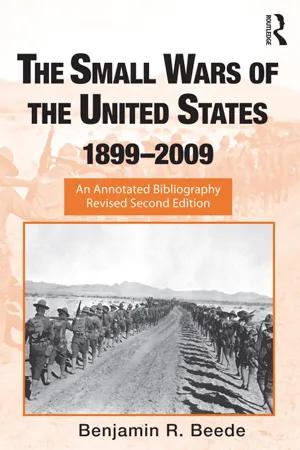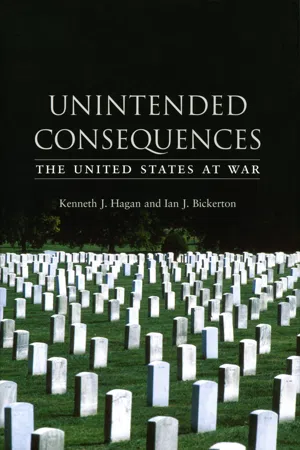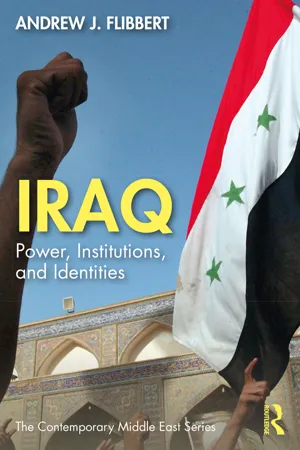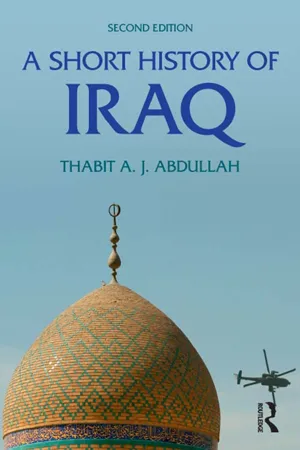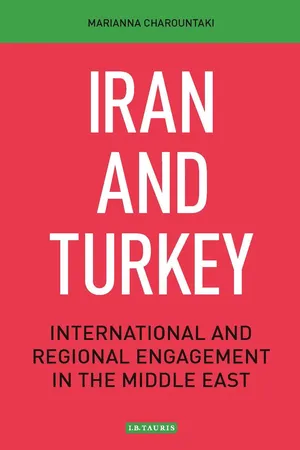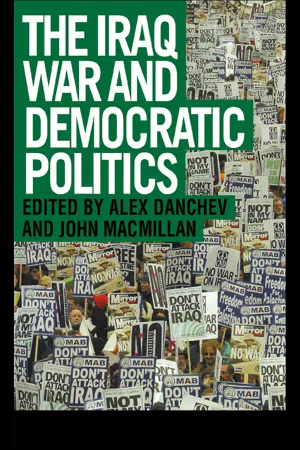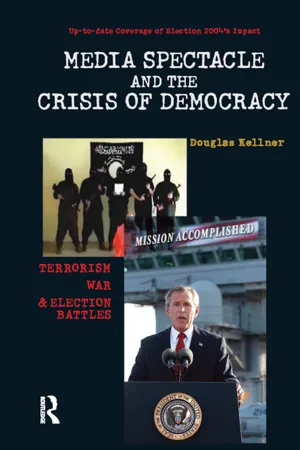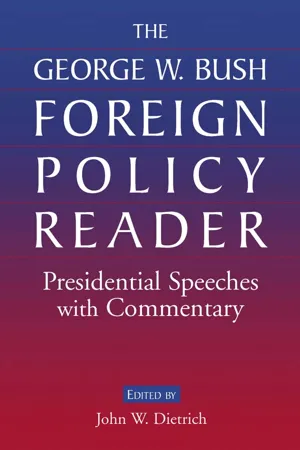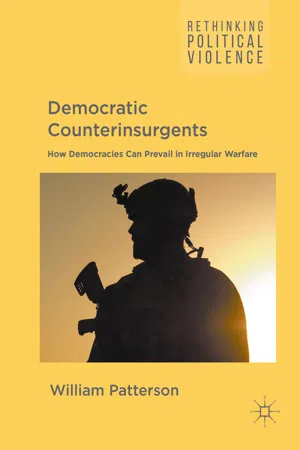History
Iraq War
The Iraq War, also known as the Second Gulf War, was a conflict that began in 2003 with the invasion of Iraq by a coalition led by the United States. The war aimed to disarm Iraq of weapons of mass destruction and remove Saddam Hussein from power. It resulted in significant loss of life, political instability, and ongoing repercussions in the region.
Written by Perlego with AI-assistance
Related key terms
1 of 4
Related key terms
1 of 3
11 Key excerpts on "Iraq War"
- eBook - ePub
The Small Wars of the United States, 1899-2009
An Annotated Bibliography
- Benjamin R. Beede(Author)
- 2012(Publication Date)
- Routledge(Publisher)
XXXIV
Iraq War, 2003–
In contrast to the Afghanistan intervention, the Iraq War became highly controversial. The principal reasons cited by the George W. Bush administration for the invasion, that Iraq was developing weapons of mass destruction and that it was cooperating with Middle Eastern extremists who were responsible for the 9/11 attack, have been discredited. The next assertions were that the Iraqi people had to be freed from a dictator and that a democratic Iraq would be a stabilizing factor in the Middle East; these have been maintained, but they remain controversial.The initial conventional offensive into Iraq was highly successful, but as has been the case with a good many wars and campaigns, including the Philippine–American War of 1899–c.1902, a guerrilla phase evolved after the end of large-scale fighting, which was considerably more difficult to confront than the conventional resistance that lasted only briefly.The complex religious, ethnic, and political divisions in Iraq grew especially acute at times, creating a strong possibility of outright civil war. Eventually, the level of violence stabilized. After it was reduced, however, violence sometimes reappeared at a relatively high level.After protracted negotiations the new Iraq government and the occupying forces agreed that the latter would depart completely from Iraq by the end of 2011. In the meantime, foreign troops were removed from urban areas to become a kind of reserve force to meet new challenges. Those troops were active in fighting guerrillas in rural parts of Iraq. - eBook - ePub
Unintended Consequences
The United States at War
- Kenneth J. Hagan, Ian J. Bickerton(Authors)
- 2007(Publication Date)
- Reaktion Books(Publisher)
TENTHE WARS AGAINST IRAQ,1991–2007
The whole last century is littered with failures of prediction.Paul Wolfowitz, June 20011The war launched against Iraq in February 2003 was billed as a war of necessity, an effort to make the United States safer following shocking attacks by suicide bombers flying commercial aircraft into the New York World Trade Center and the Pentagon building in Washington, DC , on 11 September 2001, which killed more than 3,000 people. In reality, the war was an extension of – or the completion of – the first Gulf War, ‘Operation Desert Storm’, launched against Iraq by George H. W. Bush on 17 January 1991 to force Iraq’s ruler, Saddam Hussein, to withdraw from his five-month occupation of neighbouring Kuwait.The Gulf War of 1991 was the first war fought by the United States after the collapse of the Soviet Union and the end of the Cold War. The war itself was unexpected, in that the United States was drawn into a situation it had indirectly, inadvertently, helped create. In ways reminiscent of its actions in relation to Korea in 1950, the United States in mid-1990 had conveyed ambiguous messages to the Iraqi regime, which it had formerly supported against Iran, concerning Iraq’s increasingly menacing dispute with neighbouring Kuwait. Confident that the United States would not forcefully respond, 140,000 Iraqi troops and 1,800 tanks invaded an unprepared Kuwait on 2 August 1990 and overran the small Gulf state within two days. Iraq was seeking redress for real and imagined grievances concerning massive Iraqi debts owed to Kuwait accrued during the Iraq–Iran war between 1980 and 1988, Kuwait’s overproduction of oil, and disputes between the two states about sovereignty over local islands. Arab states, the United States, the Soviet Union and many other nations immediately condemned the invasion. - eBook - ePub
Iraq
Power, Institutions, and Identities
- Andrew J. Flibbert(Author)
- 2023(Publication Date)
- Routledge(Publisher)
Together, all these factors brought about one of the most devastating regional wars of the twentieth century. 18 The war itself began with an airstrike and brief Iraqi advances into oil-rich Khuzestan in southwestern Iran, followed months later by a sharp reversal and realization that the war would not be short and easy. In fact, it lasted nearly eight years and became massive in scale and scope. The war included several phases and military theaters, and much of it was fought like the First World War, with large-scale ground offensives, the brutal use of basic technology like the machine gun, martyred Iranian human waves, and devastating Iraqi chemical attacks on both the battlefield and Kurdish civilians. It also involved air campaigns, Scud missile warfare against Iranian cities, a tanker war, and eventually an international naval dimension when the United States, Britain, and France got involved in protecting Kuwaiti oil tankers from Iranian attack. 19 Initially, Saddam put himself in charge of strategy, with poor results that led to a successful Iranian counteroffensive, driving back Iraqi forces and nearly endangering his rule. Iraqi battlefield setbacks prompted the United States to reconsider its approach and begin a significant “tilt” toward Iraq in 1982, ending its studied ambivalence toward the war out of a concern that Iran might win. It dropped Iraq from its list of state sponsors of terrorism, conducted a formal policy review, and held diplomatic discussions that included a visit from presidential envoy Donald Rumsfeld. The United States soon began providing various kinds of support to Baghdad, from agricultural credits and Export–Import Bank financing to military intelligence regarding Iranian forces. 20 Formal relations were restored in late 1984. By the mid-1980s, Iraq had the support of the United States, the Soviets, most Arab states, and much of Europe, including substantial arms sales from France, among other countries - eBook - ePub
Western Military Interventions After The Cold War
Evaluating the Wars of the West
- Marek Madej(Author)
- 2018(Publication Date)
- Routledge(Publisher)
in Iraq.At the beginning of May 2003 there was no central authority in Iraq, no military and security forces and a completely disorganised police. Once the fighting ended, the Iraqi army left behind some 60 per cent of intact or unfound weapons and ammunition. Saddam Hussein, however, remained elusive for a couple more months.In March the formal occupation of the country began, with the legal basis provided by UNSC S/RES/1483. The country was divided into three, then – from September – four occupation zones: two controlled by the US, one by the UK and one by Poland (the South Central zone – 20 per cent of the territory of Iraq). At that time, the occupation forces numbered some 150,000 soldiers: 130,000 from the US and 20,000 from other countries (including 11,000 from the UK, 3,000 from Italy, 2,300 from Poland).41Irregular armed groups had already become active in May, and with time their activity intensified. Americans and their allies seemed taken by surprise. The allied forces turned out to be unprepared for functioning in a hostile environment. During the preparations for war, military decision-makers focused on the task of conquering the enemy, neglecting preparations for any other activities, including counter-insurgency.The insurgency spread and was stepped up in 2004. The first spectacular battle between coalition (US) forces and the insurgents was the First Battle of Fallujah. After almost two months of fighting, which saw 2,200 marines with air support pitted against 12–14 various insurgent groups, the battle ended on 1 May with the US forces leaving Fallujah.During that battle insurgent groups in the central part of the country became active. Muqtada al-Sadr, Shia spiritual leader and founder of the militia called Peace Companies (Sadrist Army), took charge of the rebellion in central and southern Iraq. In April, al-Sadr’s militia controlled the cities of Kut and Najaf in the ‘Polish’ zone and captured Kufa, a city of great religious importance to Shiites.42 Operation Phantom Fury, or the Second Battle of Fallujah, which coalition (mainly US) forces fought between 7 and 16 November 2004, was much more intensive than the previous one; it also claimed more victims and created more damage. Following the intensive shelling and air strikes, a considerable portion of the city’s infrastructure was destroyed or fatally damaged; Fallujah was in ruins. In consequence of the two battles some 250,000 people had to be resettled in 2004 (before the fighting, Fallujah’s population was approximately 350,000).43 - eBook - ePub
- Scott Silverstone(Author)
- 2012(Publication Date)
- Routledge(Publisher)
7ConclusionThe Iraq War of 2003On the night of March 19, 2003, President George W. Bush announced to the nation that American military forces were in the opening stage of a war to bring down the government of Saddam Hussein in Iraq. Drawing on familiar themes deployed repeatedly for over a year, the president declared that “the people of the United States and our friends and allies will not live at the mercy of an outlaw regime that threatens the peace with weapons of mass murder.”1 Two days earlier Bush had warned that Saddam Hussein and his sons had just forty-eight hours to leave Iraq, or military force would be used to remove him from power. According to the president, this demand was a response to Iraqi defiance of “patient and honorable efforts” by the United Nations to disarm Iraq peacefully of its outlawed weapons of mass destruction (WMDs), according to its obligations emerging from the 1991 Gulf War.2 When Hussein predictably refused to accept this ultimatum, Bush launched the first true preventive war in American history.Nearly a decade earlier American leaders confronted the preventive war temptation to stop North Korea from developing its own nuclear arsenal. But with the peaceful settlement of the North Korea crisis in 1994, America avoided a true test of its tolerance for preventive war. The Iraq War of 2003 provided that test. In fact, after President Bush first announced the so-called preemption doctrine during his West Point commencement speech in June 2002, the democratic anti-preventive war norm argument would suggest that at some point on the road to war the president should have faced strong domestic opposition to this particular option for dealing with the Iraqi threat. Despite a lively public discussion, in the run-up to the Iraq conflict domestic opposition rooted in the anti-preventive war norm was marginalized and inconsequential in the ultimate decision to go to war. In fact, the Iraq War began with the backing of a healthy majority of the public and a joint congressional resolution passed in October 2002 by 77 percent in the Senate and 69 percent in the House of Representatives. The contrast in attitudes on preventive war between 2003 and the 1940s and 1950s could not be starker. In the early Cold War the anti-preventive war norm was central to the security ethos of the United States, which produced a conscious and explicit rejection of preventive war on normative grounds alone. This is not to say that the anti-preventive war norm had disappeared completely by the start of the twenty-first century. As this final chapter makes clear, there is indeed a pocket of normative resistance to preventive war among Americans that see this problem exactly as Americans at mid-century saw it. But the normative anti-preventive war perspective, which was once shared across the political spectrum and in both major political parties, is now concentrated among political liberals. - eBook - ePub
- Thabit Abdullah(Author)
- 2014(Publication Date)
- Routledge(Publisher)
CHAPTER 8 Iraq under American hegemony, 2003–2009 W hen considering Iraq’s rather sad entry into the second millennium, two factors stand out as being most decisive in bringing about foreign conquest and the loss of national sovereignty. Over a decade of the most comprehensive sanctions in modern history had left the country, including its once formidable defence establishment, in tatters. This, coupled with the fall of the Soviet Union a decade earlier, meant that there was unlikely to be any significant military or diplomatic resistance to an invasion. Second, the US inaugurated the new millennium with the election of George W. Bush Jr whose international policy was shaped primarily by neo-conservative ideas. Neo-conservative ideologues had long argued for a more forceful and direct approach to ensure US interests in Iraq and the Middle East in general. The sanctions regime in Iraq combined with the neo-conservative administration in Washington resulted in the fateful US-led invasion and occupation of the country. American rule, however, failed to bring with it the promised stability and prosperity. Not unlike the British conquest of Ottoman Iraq eight decades earlier, the Americans soon discovered that they were dealing with a highly complex society which did not bend easily to the occupier’s simplistic (and often oppressive) notions of reform and restructuring. Aside from the basic and vibrant sense of Iraqi patriotism, the occupation also underestimated the scars left behind after 24 years of Saddam’s dictatorship, which were punctuated by state terrorism, wars and sanctions. American administrative blunders, local and regional resistance, and a rising wave of sectarianism threatened to plunge the country into civil war. In the midst of this chaos, profound social transformations are still unfolding - eBook - ePub
Iran and Turkey
International and Regional Engagement in the Middle East
- Marianna Charountaki(Author)
- 2018(Publication Date)
- I.B. Tauris(Publisher)
The same factors explored in previous chapters also had a strong influence in the context of the Iraq War and the consequences which followed. This chapter will now proceed to examine the part these factors played (whether structural, internal, external, material or ideal-based, state or non-state entity related) and discuss the ways they shaped and developed Turkish–Iranian relations during this period.THE ROLE OF IRAQ IN THE FORMULATION OF TURKISH–IRANIAN RELATIONS: POLITICAL AND ECONOMIC CONSIDERATIONSWe are facing a two-generation war. And start with Iraq ….24Steve Herbits (Adviser to US Secretary of Defense, Donald Rumsfeld)The beginning of the 21st century constituted a landmark for regional politics as it heralded a new era of change. The monopolising of the US foreign policy agenda by the urgent need for the containment of global terrorism created pressure for the United States to respond to events that resulted in unexpected threats worldwide.Attention focused primarily on Iraq, which continues to preoccupy more the Turkish and to a lesser extent the Iranian foreign policy agenda, resulting in unparalleled military expenditure and signalling the peak of US external interference in the Midde Eastern region thus far, following a course of high-level political force encouraged under George W. Bush's Presidency. Bush made the controversial decision to override the UN and declare war against Iraq and Saddam on 20 March 2003, an act of aggression that marked the fifth change in US foreign policy. In addition, this period was remarkable for the intensity of explicit US interactions with non-state actors, which had a significant impact on regional politics and International Relations discipline.25The reason given for the Iraq War which aimed to liberate Iraq from Saddam's autocracy was the US allegation against Saddam based on the supposed threat posed by Iraq's possession of WMD (Weapons of Mass Destruction). The US decision to declare war represented the peak of the United State's interventionist policy which institutionalised the use of force, and thus initiated a new phase in the US relations with the Kurds of Iraq. However, Bush's policy seems to have been based on a 1992 Defense Planning Guidance foreign policy document which referenced Iraq and North Korea as primary case studies and had been unearthed by neo-cons during Bush's administration.26 Originally drafted by Paul Wolfowitz and prepared by the US Defense Department, it was re-submitted by Dick Cheney after being leaked to the New York Times and the Washington Post - eBook - ePub
- Alex Danchev, John MacMillan(Authors)
- 2004(Publication Date)
- Routledge(Publisher)
3 Bush’s war The Iraq conflict and American democracyJohn DumbrellThe Iraq War involved major, and profoundly controversial, assertions of unilateral presidential authority. Most Americans supported President George W. Bush’s decision to invade a country that had not attacked the United States. Opposition to the war encompassed neither Cabinet resignations nor mass demonstrations on the scale seen in the capital of the United States’ fellowinvader, the United Kingdom. American opposition to, and ambivalence about, the war was reflected in public opinion polling; but there was no parallel to some of the extraordinary poll results found in Western Europe. (In February 2003, Saddam Hussein and President George W.Bush were competing for the title of ‘greatest threat to world peace’.)1The early years of the twenty-first century saw an apparent widening of the Atlantic Ocean. Nevertheless, contrary to widespread European perceptions, Americans did not spend these years in a state of uninformed, blinkered and super-patriotic sentiment. Bush, after all, was a controversial leader, whose authority stemmed from the most disputed election in modern presidential history (His 2000 electoral opponent, Al Gore, was one of the first leading Democrats to criticize the administration’s line on Iraq in 2002. He described Saddam and his regime as a ‘serious threat’ to the Middle East, not an ‘imminent threat’ requiring an American invasion.)2 Timidity and self-censorship are natural characteristics of times of (real or imagined) national crisis. However, the American political process is sufficiently fragmented and multi-centred to weather such dangers. Congressional debates and actions on the war were disappointing to those participants who sought to limit the president’s discretionary authority. For Senator Robert C.Byrd, the West Virginia Democrat who emerged as the leading proponent of legislative war powers, Congress was irresponsibly allowing the executive to attack ‘any nation that the President, and the President alone, determines to be a threat’.3 Yet, the democratic process did at least allow the airing of a variety of views. According to Marcy Katpur (Democrat, Ohio) in the House of Representatives’ war debate of September 2002, ‘the driving force of this potential war on Iraq is oil’.4 Similar points apply to the American media. Americans were bombarded with debates on military action—many of them generating little more than earnestness and emotion. William Powers wrote in late March 2003: ‘Turn on CNN one recent Sunday, and you could catch Bianca Jagger earnestly debating actor Ron Silver on the merits of war.’5 - eBook - ePub
Media Spectacle and the Crisis of Democracy
Terrorism, War, and Election Battles
- Douglas Kellner(Author)
- 2015(Publication Date)
- Routledge(Publisher)
As the hawks in the Bush administration accelerated their war talk, there was a sustained array of strong criticism of the Bush war plans from throughout the world, gigantic global peace demonstrations, and objections from close U.S. allies like Canada and Germany that usually went along with U.S. military interventions. On February 13, 2003, more than 8 million people on five continents demonstrated against the planned war against Iraq. This demonstration was, according to Tariq Ali, “unprecedented in size, scope, and scale…. The turnout in western Europe broke all records: three million in Rome, two million in Spain, a million and a half in London, half a million in Berlin” (2003, 144). There was a fierce debate in Britain over whether the United Kingdom should support Bush’s venture and an indication that Tony Blair might lose support in his own party and possibly the next election if he went along with Bush.An attempt to produce a compromise resolution in the United Nations collapsed and it was simply a matter of when the war would begin.24 Whereas the explicit war aims were to shut down Iraq’s “weapons of mass destruction,” and thus enforce UN resolutions mandating that Iraq eliminate its weapons, there were many hidden agendas in the Bush administration offensive against Iraq. To be reelected, Bush needed a major victory and symbolic triumph over terrorism in order to deflect from the failings of his regime both domestically and in the realm of foreign policy.Moreover, ideologues within the Bush administration wanted to legitimate a policy of preemptive strikes, and a successful attack on Iraq could inaugurate and normalize this policy. Some of the same unilateralists in the Bush administration envisage U.S. world hegemony, the elder Bush’s “New World Order,” with the United States as the reigning military power and world police (Kellner 2003b). Increased control of the world’s oil supplies provided a tempting prize for the former oil executives who maintain key roles in the Bush administration. Furthermore, key members of the neoconservative clique in the Bush administration were linked to Israel’s reactionary Likud party, which wanted to destroy Saddam Hussein’s regime because he was seen as a threat to Israel. Finally, one might note the Oedipal Tex drama wherein George W. Bush desired to conclude his father’s unfinished business and simultaneously defeat evil to constitute himself as good, motivations that may have helped drive Bush Junior to war against Iraq with the fervor of a religious crusade.25 - eBook - ePub
The George W. Bush Foreign Policy Reader:
Presidential Speeches with Commentary
- John W. Dietrich(Author)
- 2015(Publication Date)
- Routledge(Publisher)
With encouragement from England and others, the United States did make one last effort to rally international opinion by floating a new UN resolution authorizing action. The resolution was withdrawn, though, when France threatened to veto and the resolution appeared unlikely to get support from an overall majority of countries on the Security Council. Nevertheless, the United States and a “coalition of the willing” went ahead to prepare for war, while both U.S. alliances with Europe and the UN appeared severely weakened.The War and Its Immediate Aftermath
On March 20, 2003, a coalition of roughly 100,000 American, 25,000 British, 2,000 Australian and 200 Polish soldiers began a ground offensive in Iraq. These troops numbered far fewer than the over 600,000 troops assembled for the Gulf War. Rumsfeld led the decision to rely on a smaller, faster, higher technology force, in line with his views on defense transformation. The decision initially appeared sound, as the battles were even more one-sided than expected. Less than 150 U.S. soldiers were killed as coalition forces rapidly gained control of most territory. Some military leaders on the ground, though, complained that the tactics overstretched supply lines and left troops vulnerable to rearguard attacks. Later, other critics suggested that the small number of troops made it impossible to prevent looting and establish order.There was no formal surrender by the Iraqi government to signal an end to the war. On May 1, 2003, Bush flew to the USS Abraham lincoln and spoke on its flight deck. Under a giant banner reading “Mission Accomplished,” Bush declared, “Major combat operations in Iraq have ended” (Speech 3.3 - eBook - ePub
Democratic Counterinsurgents
How Democracies Can Prevail in Irregular Warfare
- William Patterson(Author)
- 2016(Publication Date)
- Palgrave Macmillan(Publisher)
Unfortunately, the mistakes of Vietnam were repeated in Iraq. A conventional strategy was stubbornly clung to in the face of an irregular conflict. It took years for the proper adjustments to take place, years that placed Iraq, the US and its coalition partners on the path to defeat. Once those adjustments were made, the course of the war changed. The implementation of a sound counterinsurgency strategy prevented absolute defeat. Though it is hard to claim that success was achieved, it is readily apparent that major improvements in the situation were made. The pre- and post-counterinsurgency eras in Iraq were vastly different in terms of outcomes, once again demonstrating the absolute imperative of getting the planning right. In order for a democracy to win a counterinsurgency conflict, it must implement a population-centric counterinsurgency strategy.History
The Iraq War began on 20 March 2003 when the United States and its coalition partners invaded the country in order to overthrow Saddam Hussein and dismantle the regime’s supposed arsenal of weapons of mass destruction. It did not end until December 2011 when the US withdrew its last remaining combat troops. In the meantime nearly 5000 members of the coalition forces were killed and at least 100,000 Iraqi civilians similarly lost their lives. The majority of these casualties came after the initial invasion quickly and successfully overthrew Saddam Hussein’s government and destroyed his conventional military capability.The successful invasion force was small. It consisted of only three US Army divisions, one US Marine division and one British division. Including the British contingent, the number of troops involved in the invasion totaled around 145,000.1 By 9 April coalition forces had seized Baghdad and Hussein was on the run, his government having collapsed fully. President Bush announced on 1 May 2003 from the aircraft carrier USS Abraham Lincoln that major combat operations had come to a conclusive end. In the beginning, this proclamation seemed to be borne out, along with the prediction that the coalition would be greeted as liberators. There was some resistance to the occupation by former Ba’athists and foreign extremists, but violence remained low during the summer of 2003.2
Index pages curate the most relevant extracts from our library of academic textbooks. They’ve been created using an in-house natural language model (NLM), each adding context and meaning to key research topics.
Explore more topic indexes
Explore more topic indexes
1 of 6
Explore more topic indexes
1 of 4
